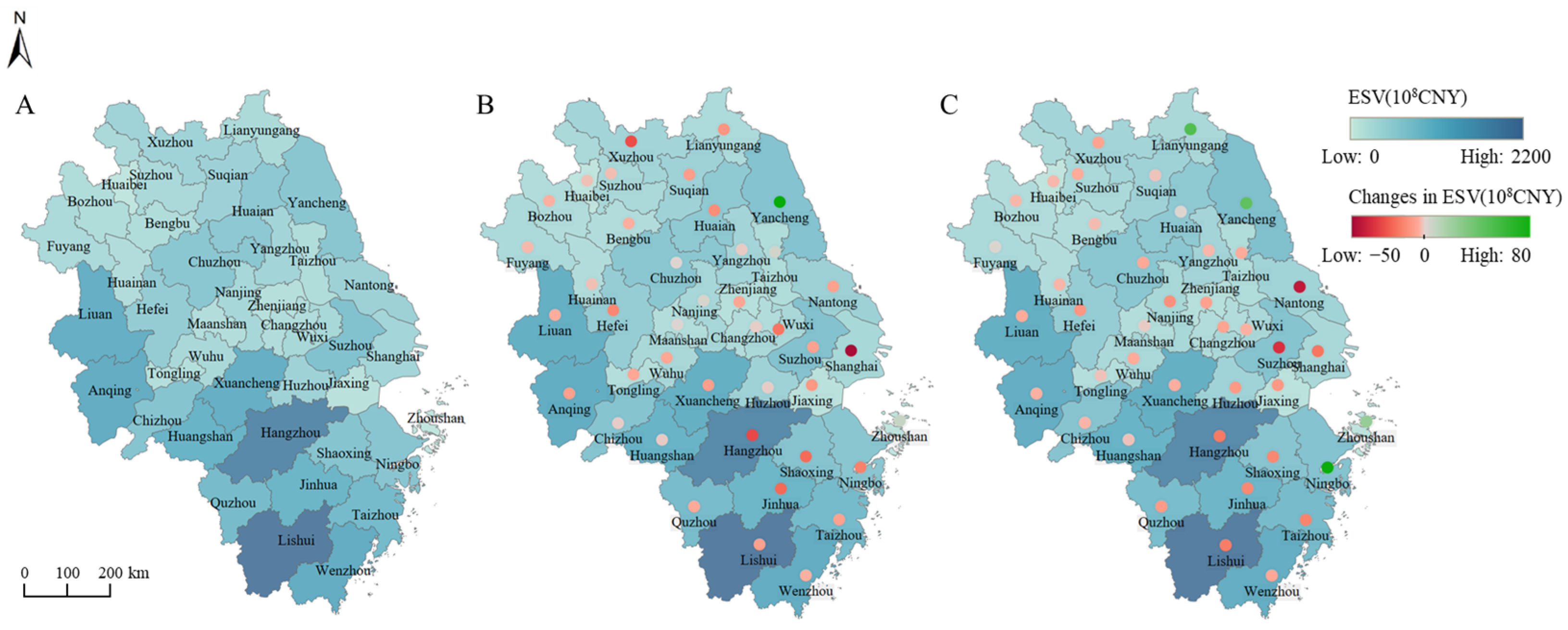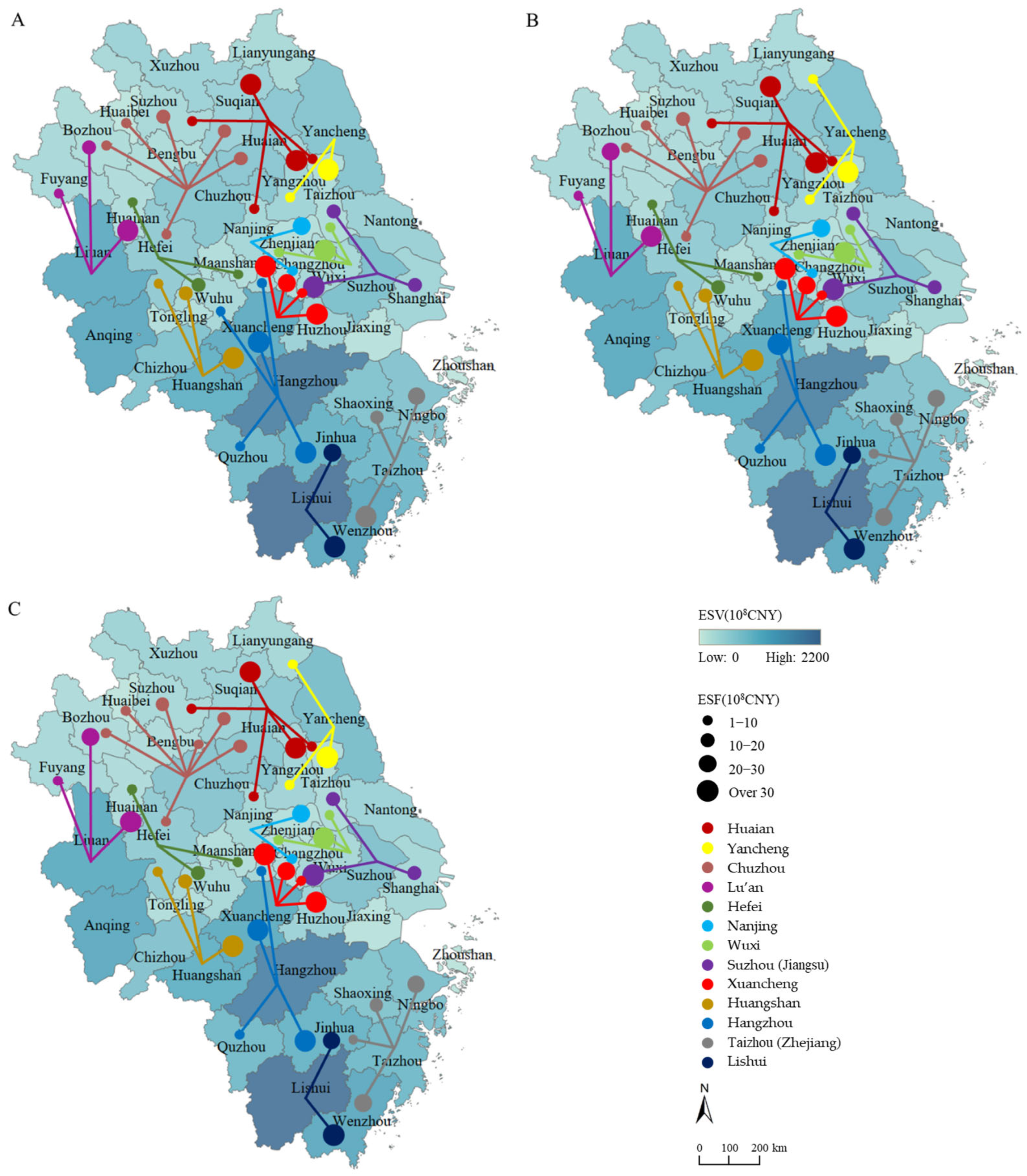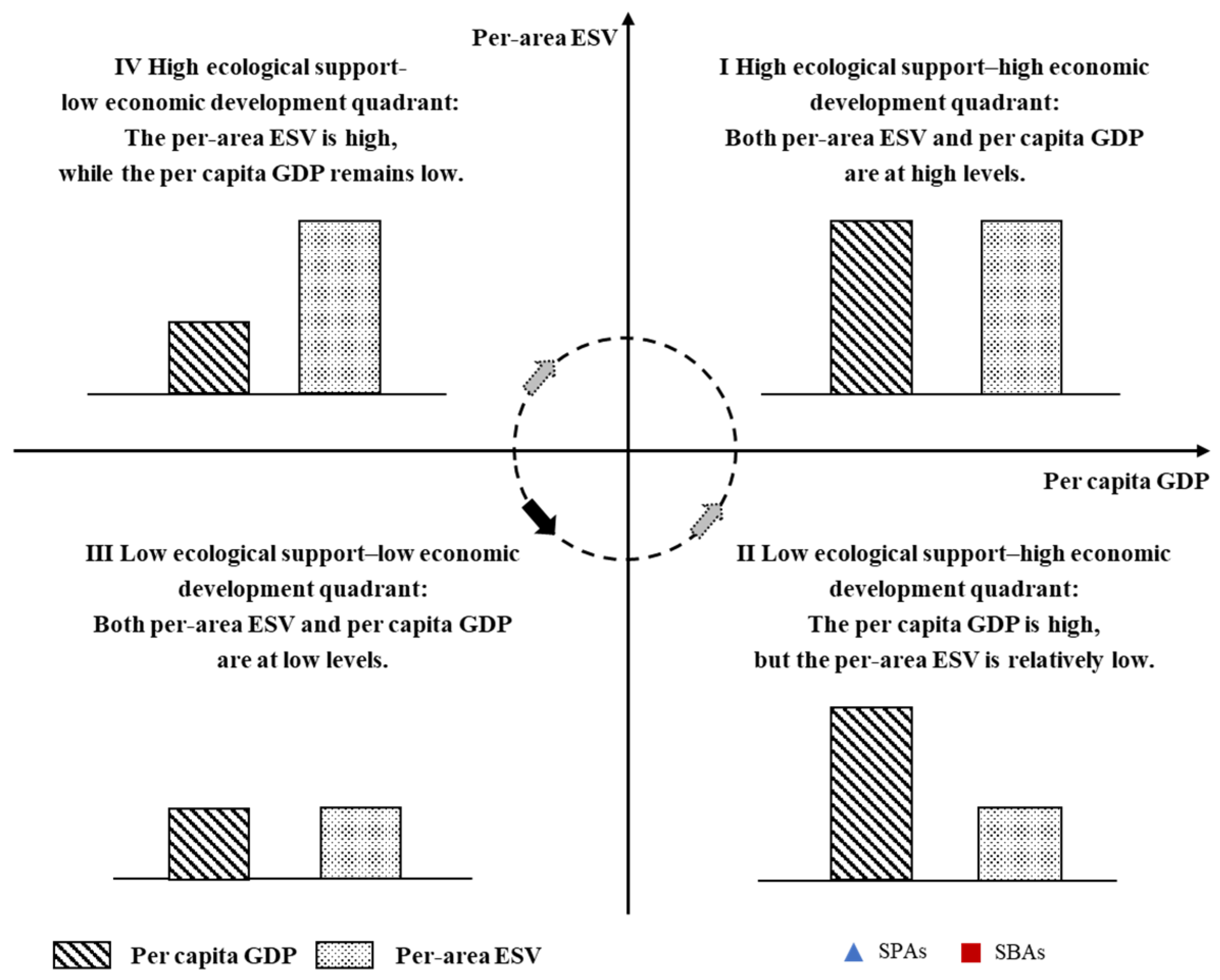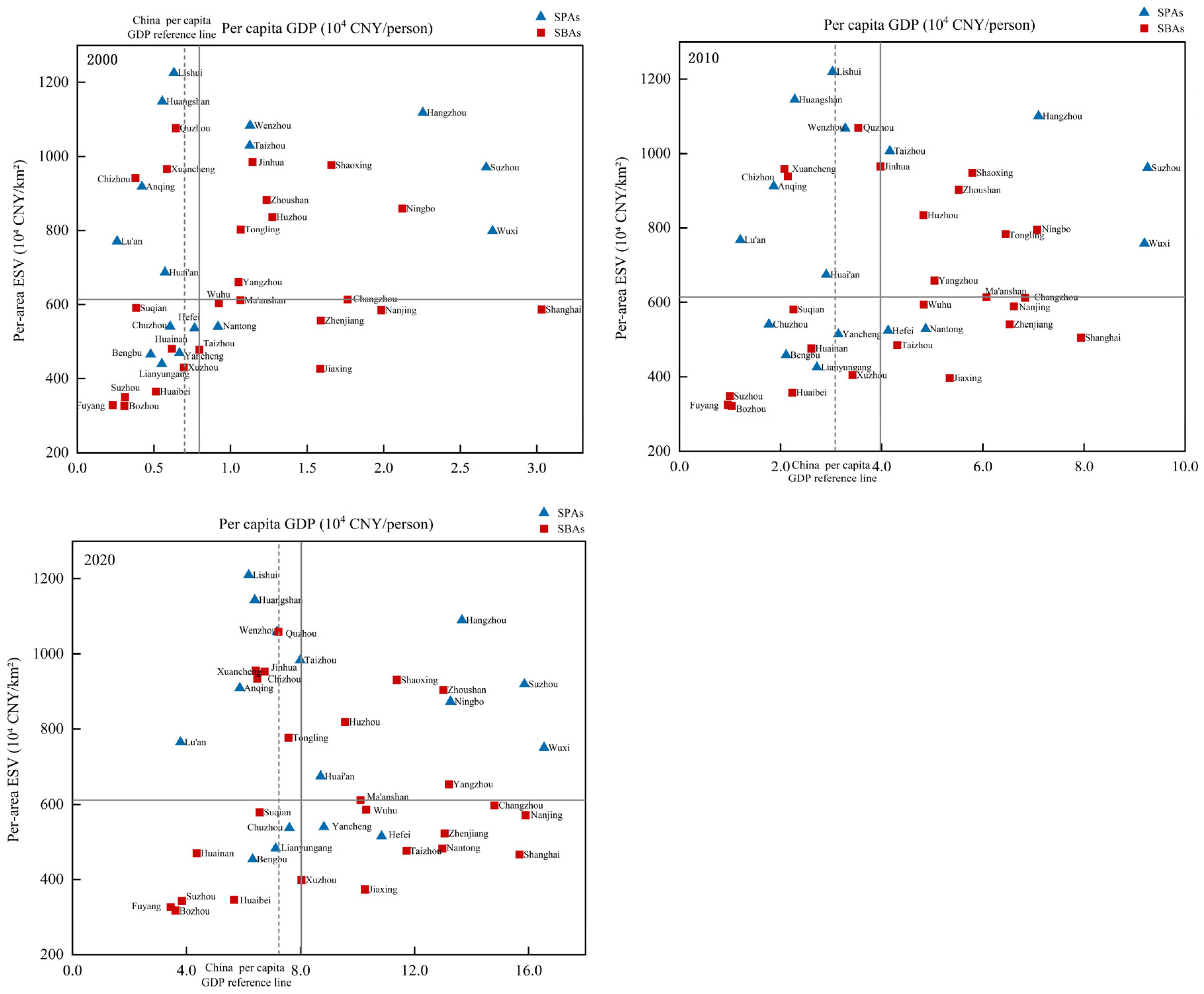Spatiotemporal Dynamics and Optimization Management of Ecosystem Service Flows in the Yangtze River Delta Urban Agglomeration, China
Abstract
1. Introduction
2. Materials and Methods
2.1. Study Area
2.2. Data Sources
2.3. Research Methods
2.3.1. Calculating the ESV
2.3.2. Calculating the ESF
3. Results
3.1. ESV
3.2. Interregional ESF
- 1.
- Core cities: Hangzhou, Suzhou (Jiangsu), Wuxi, Nanjing, Hefei, Taizhou (Zhejiang), Yancheng, Chuzhou, and Xuancheng;
- 2.
- Non-core cities: Huangshan, Lishui, Huai’an, and Lu’an;
3.3. Regional Division of the YRD from a Three-Dimensional Perspective of Ecological Support, Economic Development, and ESF
4. Discussion
5. Conclusions
- 1.
- From 2000 to 2020, the ESV of the YRD urban agglomeration exhibited a “rapid then slow” declining trend. The conversion of high-value land types, such as cropland and forest, to construction land was the main factor behind this decline, while the growth in water and the deceleration of construction land expansion slowed the decline. The ESV declined across all three provinces and one municipality, except for Yancheng, Ningbo, Lianyungang, and Zhoushan, where it increased. Among them, Yancheng showed the highest growth with an increase of CNY 11.73 billion. The regional distribution displayed a high-south, low-north spatial pattern. Among the 41 cities, over 35% of cities’ ESV was primarily contributed by forest, and 25% of cities experienced a reduction exceeding 5% in the contribution of cropland. In terms of service types, only hydrological regulation, waste treatment, and aesthetic landscape services showed value growth, while the remaining six service types continued to decline. Among these, the value of hydrological regulation services accounted for 19.3% in 2020, maintaining the largest proportion with notable growth.
- 2.
- From 2000 to 2020, ESF in the YRD urban agglomeration remained relatively stable, characterized by predominantly intra-provincial circulation. The ESF slightly increased initially in 2000 and then gradually declined, reaching CNY 211.32 billion in 2020, with an overall decrease of only 0.6%. Anhui, Jiangsu, and Zhejiang provinces primarily followed an intra-provincial circulation pattern, with internal flows accounting for over 70%. In terms of city outflows, Hangzhou, Huangshan, Xuancheng, Taizhou (Zhejiang), and Huai’an consistently ranked among the top five, collectively accounting for 41–42% of total outflows; Yancheng had the highest growth in outflows with a 35.5% increase. For city inflows, Jinhua, Xuancheng, Hangzhou, Changzhou, and Shaoxing consistently remained the top five recipients, collectively accounting for approximately 34%; Taizhou (Jiangsu) and Jiaxing were key drivers of inflow growth. In terms of net outflows/inflows, Hangzhou, Taizhou (Zhejiang), and Chuzhou had the highest net output levels, while Jinhua, Changzhou, and Taizhou (Jiangsu) had the highest net input levels. The numbers of SPAs and SBAs remained stable at 25 and 26, respectively; Nantong shifted from an SPA to an SBA in 2010, while Ningbo became an SPA in 2020.
- 3.
- A four-quadrant framework of per area ESV and per capita GDP was constructed based on ESF, classifying 41 cities in YRD into four distinct states: high ecological support–high economic development Quadrant I; low ecological support–high economic development Quadrant II; low ecological support–low economic development Quadrant III; and high ecological support–low economic development Quadrant IV. The results indicate that from 2000 to 2020, cities in YRD primarily transitioned among Quadrants I, II, and IV, with some cities moving from Quadrant III to Quadrant II, and no cities reverted to Quadrant III. Based on the four-quadrant classification, optimization management pathways and strategies for regional ecological-economic coordination were proposed. It integrates population, land, economic, and ecological dimensions to promote coordinated development. By overcoming the constraints of administrative boundaries on ecological functions and economic performance, the study puts forward ESF strategies for ecological and economic optimization. These strategies provide decision-making references for improving ecological compensation mechanisms, advancing regional collaborative governance, and facilitating the market-oriented transaction of ecosystem services.
Author Contributions
Funding
Institutional Review Board Statement
Informed Consent Statement
Data Availability Statement
Conflicts of Interest
Abbreviations
| ESV | Ecosystem service value |
| ESF | Ecosystem service flow |
| YRD | Yangtze River Delta |
References
- Costanza, R.; de Groot, R.; Braat, L.; Kubiszewski, I.; Fioramonti, L.; Sutton, P.; Farber, S.; Grasso, M. Twenty Years of Ecosystem Services: How Far Have We Come and How Far Do We Still Need to Go? Ecosyst. Serv. 2017, 28, 1–16. [Google Scholar] [CrossRef]
- Xiao, Y.; Xie, G.; Lu, C.; Xu, J. Involvement of ecosystem service flows in human wellbeing based on the relationship between supply and demand. Acta Ecol. Sin. 2016, 36, 3096–3102. [Google Scholar] [CrossRef]
- Peng, J.; Hu, X.; Zhao, M.; Liu, Y.; Tian, L. Research progress on ecosystem service trade-offs: From cognition to decision-making. Acta Geogr. Sin. 2017, 72, 960–973. [Google Scholar] [CrossRef]
- Boyd, J.; Banzhaf, S. What Are Ecosystem Services? The Need for Standardized Environmental Accounting Units. Ecol. Econ. 2007, 63, 616–626. [Google Scholar] [CrossRef]
- Bai, Y.; Wong, C.P.; Jiang, B.; Hughes, A.C.; Wang, M.; Wang, Q. Developing China’s Ecological Redline Policy Using Ecosystem Services Assessments for Land Use Planning. Nat. Commun. 2018, 9, 3034. [Google Scholar] [CrossRef]
- Arunrat, N.; Sereenonchai, S.; Wang, C. Carbon Footprint and Predicting the Impact of Climate Change on Carbon Sequestration Ecosystem Services of Organic Rice Farming and Conventional Rice Farming: A Case Study in Phichit Province, Thailand. J. Environ. Manag. 2021, 289, 112458. [Google Scholar] [CrossRef]
- Wu, Q.; Cao, Y.; Fang, X.; Wang, J.; Li, G. A Systematic Coupling Analysis Framework and Multi-Stage Interaction Mechanism between Urban Land Use Efficiency and Ecological Carrying Capacity. Sci. Total Environ. 2022, 853, 158444. [Google Scholar] [CrossRef]
- Baró, F.; Palomo, I.; Zulian, G.; Vizcaino, P.; Haase, D.; Gómez-Baggethun, E. Mapping Ecosystem Service Capacity, Flow and Demand for Landscape and Urban Planning: A Case Study in the Barcelona Metropolitan Region. Land Use Policy 2016, 57, 405–417. [Google Scholar] [CrossRef]
- Song, X.-P.; Hansen, M.C.; Stehman, S.V.; Potapov, P.V.; Tyukavina, A.; Vermote, E.F.; Townshend, J.R. Global Land Change from 1982 to 2016. Nature 2018, 560, 639–643. [Google Scholar] [CrossRef]
- Liu, L.; Wu, J. Ecosystem Services-Human Wellbeing Relationships Vary with Spatial Scales and Indicators: The Case of China. Resour. Conserv. Recycl. 2021, 172, 105662. [Google Scholar] [CrossRef]
- Hein, L.; van Koppen, K.; de Groot, R.S.; van Ierland, E.C. Spatial Scales, Stakeholders and the Valuation of Ecosystem Services. Ecol. Econ. 2006, 57, 209–228. [Google Scholar] [CrossRef]
- Kroll, F.; Müller, F.; Haase, D.; Fohrer, N. Rural–Urban Gradient Analysis of Ecosystem Services Supply and Demand Dynamics. Land Use Policy 2012, 29, 521–535. [Google Scholar] [CrossRef]
- Liu, H.; Fan, Y.; Ding, S. Research progress of ecosystem service flow. Chin. J. Appl. Ecol. 2016, 27, 2161–2171. [Google Scholar] [CrossRef]
- Li, S.; Zhang, C.; Liu, J.; Zhu, W.; Ma, C.; Wang, J. The tradeoffs and synergies of ecosystem services: Research progress, development trend, and themes of geography. Geogr. Res. 2013, 32, 1379–1390. [Google Scholar]
- Serna-Chavez, H.M.; Schulp, C.J.E.; van Bodegom, P.M.; Bouten, W.; Verburg, P.H.; Davidson, M.D. A Quantitative Framework for Assessing Spatial Flows of Ecosystem Services. Ecol. Indic. 2014, 39, 24–33. [Google Scholar] [CrossRef]
- Wang, J.; Zhou, W. Ecosystem service flows: Recent progress and future perspectives. Acta Ecol. Sin. 2019, 39, 4213–4222. Available online: https://kns.cnki.net/kcms2/article/abstract?v=TD_mLQSGK6ualo9_AYoF3aCIznRzGnXnm5n9dmxaTuEugOBgnHFf7OHqGpJfe0ndRY4YUICIhKXbf0Z2bRjdiO6z2NnkNTB4Cpy0ZrGyy9Ndx1uTmF_5fpZDRkHTJ8Zn1oR0EJl75kzP7pbam9ACD6ky4kGYhBQLaX2A5SfAM_HO3TpAnUyzjQ==&uniplatform=NZKPT&language=CHS (accessed on 10 May 2024).
- López-Hoffman, L.; Varady, R.G.; Flessa, K.W.; Balvanera, P. Ecosystem Services across Borders: A Framework for Transboundary Conservation Policy. Front. Ecol. Environ. 2010, 8, 84–91. [Google Scholar] [CrossRef]
- Koellner, T.; Bonn, A.; Arnhold, S.; Bagstad, K.J.; Fridman, D.; Guerra, C.A.; Kastner, T.; Kissinger, M.; Kleemann, J.; Kuhlicke, C.; et al. Guidance for Assessing Interregional Ecosystem Service Flows. Ecol. Indic. 2019, 105, 92–106. [Google Scholar] [CrossRef]
- Feurer, M.; Rueff, H.; Celio, E.; Heinimann, A.; Blaser, J.; Htun, A.M.; Zaehringer, J.G. Regional Scale Mapping of Ecosystem Services Supply, Demand, Flow and Mismatches in Southern Myanmar. Ecosyst. Serv. 2021, 52, 101363. [Google Scholar] [CrossRef]
- Shakya, B.; Uddin, K.; Yi, S.; Bhatta, L.D.; Lodhi, M.S.; Htun, N.Z.; Yang, Y. Mapping of the Ecosystem Services Flow from Three Protected Areas in the Far-Eastern Himalayan Landscape: An Impetus to Regional Cooperation. Ecosyst. Serv. 2021, 47, 101222. [Google Scholar] [CrossRef]
- Bagstad, K.J.; Semmens, D.J.; Diffendorfer, J.E.; Mattsson, B.J.; Dubovsky, J.; Thogmartin, W.E.; Wiederholt, R.; Loomis, J.; Bieri, J.A.; Sample, C.; et al. Ecosystem Service Flows from a Migratory Species: Spatial Subsidies of the Northern Pintail. Ambio 2019, 48, 61–73. [Google Scholar] [CrossRef] [PubMed]
- Liu, W.; Zhan, J.; Zhao, F.; Zhang, F.; Teng, Y.; Wang, C.; Chu, X.; Kumi, M.A. The Tradeoffs between Food Supply and Demand from the Perspective of Ecosystem Service Flows: A Case Study in the Pearl River Delta, China. J. Environ. Manag. 2022, 301, 113814. [Google Scholar] [CrossRef] [PubMed]
- Lin, J.; Huang, J.; Prell, C.; Bryan, B.A. Changes in Supply and Demand Mediate the Effects of Land-Use Change on Freshwater Ecosystem Services Flows. Sci. Total Environ. 2021, 763, 143012. [Google Scholar] [CrossRef]
- Schirpke, U.; Candiago, S.; Egarter Vigl, L.; Jäger, H.; Labadini, A.; Marsoner, T.; Meisch, C.; Tasser, E.; Tappeiner, U. Integrating Supply, Flow and Demand to Enhance the Understanding of Interactions among Multiple Ecosystem Services. Sci. Total Environ. 2019, 651, 928–941. [Google Scholar] [CrossRef] [PubMed]
- Wang, Z.; Zhang, L.; Li, X.; Li, Y.; Frans, V.F.; Yan, J. A Network Perspective for Mapping Freshwater Service Flows at the Watershed Scale. Ecosyst. Serv. 2020, 45, 101129. [Google Scholar] [CrossRef]
- Qiao, X.; Zhang, T.; Yang, Y.; Niu, H.; Yang, D. Spatial flow of ecosystem services and impacts on human well-being in the Weigan River Basin. Resour. Sci. 2017, 39, 533–544. [Google Scholar] [CrossRef][Green Version]
- Nikodinoska, N.; Paletto, A.; Pastorella, F.; Granvik, M.; Franzese, P.P. Assessing, Valuing and Mapping Ecosystem Services at City Level: The Case of Uppsala (Sweden). Ecol. Model. 2018, 368, 411–424. [Google Scholar] [CrossRef]
- Shen, J.; Wang, Y. Allocating and Mapping Ecosystem Service Demands with Spatial Flow from Built-up Areas to Natural Spaces. Sci. Total Environ. 2021, 798, 149330. [Google Scholar] [CrossRef]
- Zhai, T.; Zhang, D.; Zhao, C. How to Optimize Ecological Compensation to Alleviate Environmental Injustice in Different Cities in the Yellow River Basin? A Case of Integrating Ecosystem Service Supply, Demand and Flow. Sustain. Cities Soc. 2021, 75, 103341. [Google Scholar] [CrossRef]
- Goldenberg, R.; Kalantari, Z.; Cvetkovic, V.; Mörtberg, U.; Deal, B.; Destouni, G. Distinction, Quantification and Mapping of Potential and Realized Supply-Demand of Flow-Dependent Ecosystem Services. Sci. Total Environ. 2017, 593–594, 599–609. [Google Scholar] [CrossRef]
- Li, D.; Wu, S.; Liu, L.; Liang, Z.; Li, S. Evaluating Regional Water Security through a Freshwater Ecosystem Service Flow Model: A Case Study in Beijing-Tianjian-Hebei Region, China. Ecol. Indic. 2017, 81, 159–170. [Google Scholar] [CrossRef]
- Chen, R.; Zhang, D.; Li, B. Spatial–Temporal Calculation Simulation of Ecological Footprint of Resource and Environmental Pollution in Green Communication. EURASIP J. Wirel. Commun. Netw. 2020, 2020, 258. [Google Scholar] [CrossRef]
- Bai, J.; Li, J.; Zhou, Z.; Dang, H.; Zhang, Y.; Wang, C.; Sun, Y. Actual Supply of Soil Conservation Services Limits Their Use: From an Ecosystem Service Flow Perspective. Ecol. Indic. 2025, 173, 113420. [Google Scholar] [CrossRef]
- Hu, Y.; Pan, T.; Zhang, W. On the Economic Growth Effect of the Coordinated Innovation of the Yangtze River Delta Urban Agglomeration under the Integrated National Strategy. J. East China Norm. Univ. (Humanit. Soc. Sci.) 2019, 51, 99–106. [Google Scholar] [CrossRef]
- Zhang, X.; Lin, Y.; Meng, M. The Evolution of Regional Integration Development Mechanism in the Yangtze River Delta: Experiences and Future Trends. J. Anhui Univ. (Philos. Soc. Sci. Ed.) 2019, 43, 138–147. [Google Scholar] [CrossRef]
- Reid, W.; Mooney, H.; Cropper, A.; Capistrano, D.; Carpenter, S.; Chopra, K. Ecosystems and Human Well-Being: Synthesis; World Resources Institute: Washington, DC, USA, 2005; pp. 39–45. [Google Scholar]
- Costanza, R.; d’Arge, R.; de Groot, R.; Farber, S.; Grasso, M.; Hannon, B.; Limburg, K.; Naeem, S.; O’Neill, R.V.; Paruelo, J.; et al. The Value of the World’s Ecosystem Services and Natural Capital. Nature 1997, 387, 253–260. [Google Scholar] [CrossRef]
- Xie, G.; Zhen, L.; Lu, C.; Xiao, Y.; Chen, C. Expert Knowledge Based Valuation Method of Ecosystem Services in China. J. Nat. Resour. 2008, 23, 911–919. [Google Scholar] [CrossRef]
- Xie, G.; Zhang, C.; Zhang, L.; Chen, W.; Li, S. Improvement of the Evaluation Method for Ecosystem Service Value Based on Per Unit Area. J. Nat. Resour. 2015, 30, 1243–1254. [Google Scholar] [CrossRef]
- Su, K.; Wei, D.; Lin, W. Evaluation of Ecosystem Services Value and Its Implications for Policy Making in China—A Case Study of Fujian Province. Ecol. Indic. 2020, 108, 105752. [Google Scholar] [CrossRef]
- Niu, H.; An, R.; Xiao, D.; Liu, M.; Zhao, X. Estimation of Ecosystem Services Value at a Basin Scale Based on Modified Equivalent Coefficient: A Case Study of the Yellow River Basin (Henan Section), China. Int. J. Environ. Res. Public Health 2022, 19, 16648. [Google Scholar] [CrossRef]
- Zhang, J.; He, C.; Huang, Q.; Li, L. Understanding Ecosystem Service Flows through the Metacoupling Framework. Ecol. Indic. 2023, 151, 110303. [Google Scholar] [CrossRef]
- Zhang, X.-L.; Niu, C.-H.; Ma, S.; Wang, L.-J.; Hu, H.-B.; Jiang, J. Exploring Ecological Compensation Standards in the Urbanization Process: An Ecosystem Service Value-Based Perspective. Ecol. Indic. 2024, 166, 112510. [Google Scholar] [CrossRef]
- Wang, T.; Wang, X.; Qin, Y.; Gao, P.; Wang, H. Spatial-temporal Correlation Analysis of Ecosystem Services Value and Human Activities in Danjiangkou Reservoir Area. Resour. Environ. Yangtze Basin 2021, 30, 330–341. [Google Scholar] [CrossRef]
- Converse, P.D.; Reilly, W.J. New Laws of Retail Gravitation. J. Mark. 1949, 14, 379–384. [Google Scholar] [CrossRef]
- Chang, H.; Geng, W.; Zhang, P.; Shao, J.; Liu, Z.; Lou, Y.; Wang, Q.; Zhang, J.; Zhu, H. Study on the Evolution of Urban Radiation Intensity and Pattern in Henan Province. J. Henan Univ. (Nat. Sci.) 2021, 51, 524–534. [Google Scholar] [CrossRef]
- Tan, F.; Lu, Z. Regional Sustainability System as Ecosystem: Case Study of China’s Two Leading Economic Circles from a Keystone Perspective. Environ. Dev. Sustain. 2019, 21, 961–983. [Google Scholar] [CrossRef]
- Liu, M.; Fan, J.; Wang, Y.; Hu, C. Study on Ecosystem Service Value (ESV) Spatial Transfer in the Central Plains Urban Agglomeration in the Yellow River Basin, China. Int. J. Environ. Res. Public Health 2021, 18, 9751. [Google Scholar] [CrossRef]
- Wang, C.; Li, W.; Sun, M.; Wang, Y.; Wang, S. Exploring the Formulation of Ecological Management Policies by Quantifying Interregional Primary Ecosystem Service Flows in Yangtze River Delta Region, China. J. Environ. Manag. 2021, 284, 112042. [Google Scholar] [CrossRef]
- Ji, Q.; Feng, X.; Sun, S.; Zhang, J.; Li, S.; Fu, B. Cross-Scale Coupling of Ecosystem Service Flows and Socio-Ecological Interactions in the Yellow River Basin. J. Environ. Manag. 2024, 367, 122071. [Google Scholar] [CrossRef]
- Chi, C.; Shen, J.; Gao, X.; Hu, P.; Yi, P. Horizontal Ecological Compensation Standards Based on Ecosystem Services Flow. Ecol. Indic. 2024, 163, 112081. [Google Scholar] [CrossRef]
- Wu, J.; Feng, Z.; Zhang, X.; Xu, Y.; Peng, J. Delineating Urban Hinterland Boundaries in the Pearl River Delta: An Approach Integrating Toponym Co-Occurrence with Field Strength Model. Cities 2020, 96, 102457. [Google Scholar] [CrossRef]
- Fan, X.; Gao, J.; Wen, W. Exploratory Study on Eco-Assets Transferring and the Valuating Models. Res. Environ. Sci. 2007, 20, 160–164. [Google Scholar] [CrossRef]
- Dolan, R.; Bullock, J.M.; Jones, J.P.G.; Athanasiadis, I.N.; Martinez-Lopez, J.; Willcock, S. The Flows of Nature to People, and of People to Nature: Applying Movement Concepts to Ecosystem Services. Land 2021, 10, 576. [Google Scholar] [CrossRef]








| Initial Quadrant | Final Quadrant | Cities |
|---|---|---|
| High ecological support–high economic development quadrant I | Low ecological support–high economic development quadrant II | Changzhou |
| High ecological support–high economic development quadrant I | High ecological support–low economic development quadrant IV | Taizhou (Zhejiang), Jinhua, Tongling, and Wenzhou |
| Low ecological support–high economic development quadrant II | High ecological support–high economic development quadrant I | Ma’anshan |
| High ecological support–low economic development quadrant IV | High ecological support–high economic development quadrant I | Huai’an |
| Low ecological support–low economic development quadrant III | Low ecological support–high economic development quadrant II | Yancheng, Xuzhou, Hefei, and Taizhou (Jiangsu) |
Disclaimer/Publisher’s Note: The statements, opinions and data contained in all publications are solely those of the individual author(s) and contributor(s) and not of MDPI and/or the editor(s). MDPI and/or the editor(s) disclaim responsibility for any injury to people or property resulting from any ideas, methods, instructions or products referred to in the content. |
© 2025 by the authors. Licensee MDPI, Basel, Switzerland. This article is an open access article distributed under the terms and conditions of the Creative Commons Attribution (CC BY) license (https://creativecommons.org/licenses/by/4.0/).
Share and Cite
Jia, H.; Chen, H. Spatiotemporal Dynamics and Optimization Management of Ecosystem Service Flows in the Yangtze River Delta Urban Agglomeration, China. Sustainability 2025, 17, 4727. https://doi.org/10.3390/su17104727
Jia H, Chen H. Spatiotemporal Dynamics and Optimization Management of Ecosystem Service Flows in the Yangtze River Delta Urban Agglomeration, China. Sustainability. 2025; 17(10):4727. https://doi.org/10.3390/su17104727
Chicago/Turabian StyleJia, Huilan, and Hongmin Chen. 2025. "Spatiotemporal Dynamics and Optimization Management of Ecosystem Service Flows in the Yangtze River Delta Urban Agglomeration, China" Sustainability 17, no. 10: 4727. https://doi.org/10.3390/su17104727
APA StyleJia, H., & Chen, H. (2025). Spatiotemporal Dynamics and Optimization Management of Ecosystem Service Flows in the Yangtze River Delta Urban Agglomeration, China. Sustainability, 17(10), 4727. https://doi.org/10.3390/su17104727





